Biology Chapter 5 Morphology Of Flowering Plants
Sponsor Area
NCERT Solution For Class 11 Political+science Biology
What is meant by modification of root? What type of modification of root is found in the:
(a) Banyan tree
(b) Turnip
(c) Mangrove trees
Modification of the roots means change in the root shape and structure to perform function other than absorption and conduction of water and minerals. Roots are modified to perform specialised functions like support, storage of food and respiration.
Roots and its modifications in various plants:
(a) Banyan tree
The banyan tree has prop roots. Prop roots are massive pillar-like adventitious roots arising from the aerial part of the stem. These roots grow towards the ground and provide support to the tree.
(b) Turnip
The tap roots of turnip swell and help in the storage of food.
(c) Mangrove tree
The roots modification found in mangroves are pneumatophores. The roots grow vertically upwards from the soil for the absorption of oxygen from the atmosphere as the soil is poorly aerated
Justify the following statements on the basis of external features:
(i) Underground parts of a plant are not always roots.
(ii) Flower is a modified shoot.
(i) Underground parts of a plant are not always roots: There are certain plants like potato , ginger turmeric in which the stem is modified for the storage of the food and is found underground. In these, the stem becomes swollen due to storage of food. The potato bears eyes, which are subtended by a leaf scar. Basal leaves in onions become fleshy because of the accumulation of food and are found under the ground. Since stem, leaves can be modified to be found underground, we can say that the underground parts of the plant are not always roots.
(ii) Flower is a modified shoot: The shoot apical meristem changes to floral meristem. The axis of the stem gets condensed, while the internodes lie near each other. The apex produces different kinds of floral appendages laterally at successive nodes of the leaves. Instead of leaves, various floral appendages arise from the node. Therefore, the flower can be said to be a flower is a modified shoot.
How is a pinnately compound leaf different from a palmately compound leaf?
|
Pinnately Compound Leaf |
Palmately Compound Leaf
|
|
The leaflets are attached to the common axis, called rachis.
|
The leaflets are attached at a common point on the leaf stalk.
|
|
For example - neem |
For example- silk cotton |
Explain with suitable examples the different types of phyllotaxy.
Phyllotaxy refers to the pattern or arrangement of leaves on the stem or branch of a plant. It is usually of three types:
(i) Alternate: In alternate phyllotaxy, a single leaf arises from the node of a branch. This type of phyllotaxy is observed in the sunflower, mustard, and peepal.
(ii) Opposite: In this type the plants has two leaves arising from the node in opposite directions. It is found in guava.
(iii) Whorled: Plants with whorled phyllotaxy have three or more leaves arising from the node. It is found in Alstonia.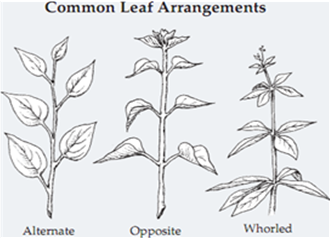
Define the following terms:
(a) aestivation
It is the mode of arrangement of sepals or petals in floral bud with respect to the other members of the same whorl.
Define the following terms:
(c) placentation
The term ‘placentation’ refers to the arrangement of ovules within the ovary of a flower.
Define the following terms:
(c) actinomorphic
Actinomorphic flowers are those which can be divided into equal radial halves by any radial plane passing through its centre. Examples: chilly and mustard.
Define the following terms:
(d) zygomorphic
Zygomorphic flowers are those flowers which can be divided into two similar halves only by a single vertical plane. Example: pea and beans.
Define the following terms:
(e) superior ovary
The condition where the gynoecium in the flower is present at the highest position, while other floral parts are arranged below. A flower with this arrangement is also called hypogynous. Examples: brinjal and mustard.
Define the following terms:
perigynous flower
Perigynous flower: In perigynous flowers, the gynoecium is present in the centre and the rest of the floral parts are arranged at the rim of the thalamus at the same level. Examples – plum and rose.
Define the following terms:
epipetalous stamen
Epipetalous stamen: It is the condition when the stamens are attached to the petals. They are found in brinjal.
Define the following terms:
(a) Racemose and cymose inflorescence
|
Racemose inflorescence |
Cymose inflorescence |
|
Younger flowers are present at the tip while older flowers are arranged at the base i.e acropetal order. |
Younger flowers are present at the base of the inflorescence, while older flowers are present at the top. |
|
Main axis keeps on growing. |
Main axis has limited growth. |
|
Flowers are borne laterally. |
Flowers are borne at the apex. |
Define the following terms:
(b) Fibrous root and adventitious root
|
Fibrous root |
Adventitious root. |
|
Primary root is short lived and is replaced by a large number of roots. Roots arise from the base of the stem. |
Roots arise from any part of the plant other than the radicle of seeds.
|
|
Eg: root of wheat |
E.g. grasses like monstera. |
Define the following terms:
(c) Apocarpous and syncarpous ovary
|
Apocarpous ovary |
Syncarpous ovary |
|
When more than one carpel is present and the carpels are free. |
When the carpels are fused. |
|
e.g lotus |
e.g mustard |
Draw the labelled diagram of the following:
(i) Gram seed (ii) V.S. of maize seed
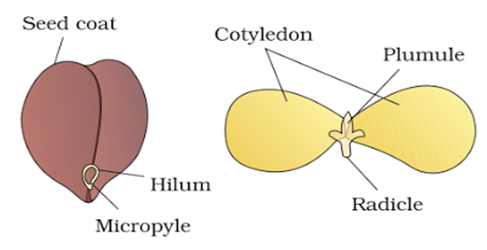
(ii) V.S. of maize seed:
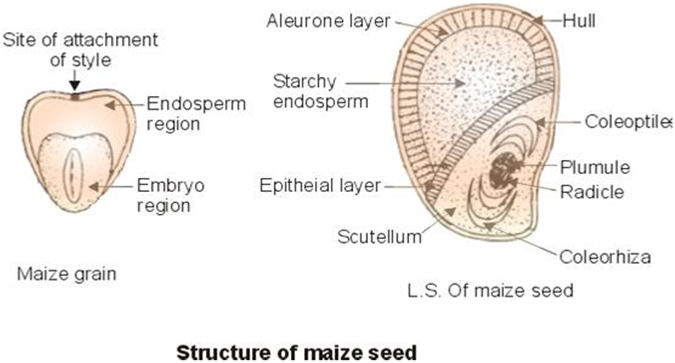
Describe modifications of stem with suitable examples.
The stem may be modified for:
(a) Storage – Underground stems of plants like potato are modified into tubers which perform the function of storing food. Stem of plants like ginger are modified into rhizome while the stem of colocasia are modified into corm. All these stem modification perform the function of storing food.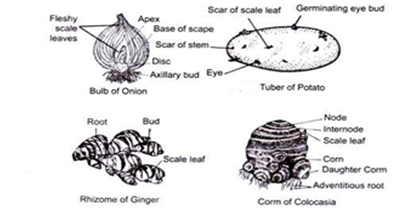
(b) Support – Stem of the plants like gravevine and pumpkin are modified into tendrils. These tendrils are slender and spirally coil that help the plant to climb and provide support. 
(c) Protection – Stem of plants like Citrus and Bougainvillea are modified into thorns which protect the plants from the browsing animals.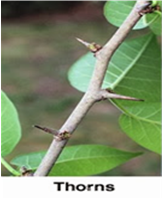
(d) Photosynthesis – Plants like Opuntia have modified stems which are flattened, fleshy and contain chlorophyll that carries out photosynthesis. 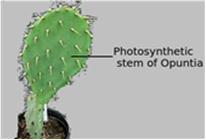
(e) Spread – Stem of plants like strawberry is modified into a Stolon that spreads to new niches. Plants like Pistia possess stem which is modified into Offset, which has a lateral branch with short internodes and each node bearing a tuft of rosette leaves. Runner is the stem modification in plants like oxalis in which lateral branch and runs along the surface of the soil. It develops distinct nodes and internodes. At each node, the runner produces roots below and leaves above. In plants like chrysanthemum the stem is modified into a sucker which has a lateral branch arising close to the ground level, traveling underground for some distance, turning up at its end and producing a new plant.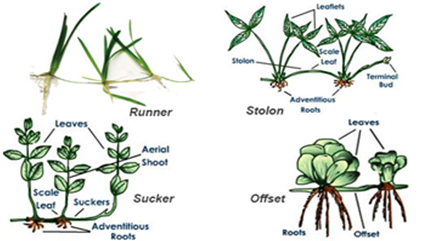
(f) Vegetative propagation - The short lateral stem called the offset in some aquatic plants (such as Eichhornia) bears leaves and tufts of roots at the node and gives rise to new plants.
Take one flower each of the families Fabaceae and Solanaceae and write its semi-technical description. Also draw their floral diagram after studying them.
Semi-technical descriptions of flowers of following families are:
Fabaceae
Family - Fabaceae
Vegetative characters
Herb
Leaf: Pinnately compound, alternately arranged with leaf tendrils with the pulvinus present at the leaf base. Venation is reticulate.
Root: Tap root system with root nodules.
Floral features:
Inflorescence: racemose .
Flower: zygomorphic and bisexual.
Calyx: Sepals which are gamosepalous while aestivation is imbricate.
Corolla: five petals (polypetalous) with vexillary aestivation.
Androecium: ten anthers that are diadelphous with dithecous anthers.
Gynoecium: Monocarpellary superior ovary which is unilocular with marginal placentation.
Fruit: Legume pod with non-endospermic seeds
Floral formula:
Floral Diagram:
Solanaceae
Solanum lycopersicum (Tomato)
Family - Solanaceae
Vegetative characters
Shrub
Stem: herbaceous stem, aerial, erect , branched solid
Leaf: alternate , simple, exstipulate and reticulate venation
Floral features:
Inflorescence: Cymose
Flower: bisexual and actinomorphic.
Calyx: five sepals, united persistant, valvate aestivation
Corolla: five petals, united, valvate aestivation
Androecium: five stamens, epipetalous
Gynoecium: bicarpellary, syncarpous superior ovary, bilocular, placenta swollen with many ovules
Fruit: berry
Seeds: many endosperms
Sponsor Area
Describe the various types of placentations found in flowering plants.
Placentation refers to the arrangement of ovules inside the ovary. It is of five basic types.
(A) Marginal placentation:
The ovary in which the placenta forms a ridge along the ventral suture of the ovary and the ovules develop on two separate rows is known to have marginal placentation. e.g peas.
(B) Parietal placentation:
When the ovules develop on the inner walls of the ovary, the ovary is said to have parietal placentation. Ovary is one chambered but it becomes two chambered due to the formation of the false septum. e.g mustard.
(C) Axile placentation:
In axile placentation, the placenta is axial and ovules are attached to it. e.g China rose.
(D) Basal placentation:
The ovary in which the placenta develops from its base and a single ovule is found attached to the base is said to have basal placentation. e.g marigold.
(E) Free central placentation:
In free central placentation, the ovules develop on the central axis while the septa are absent. e.g Dianthus.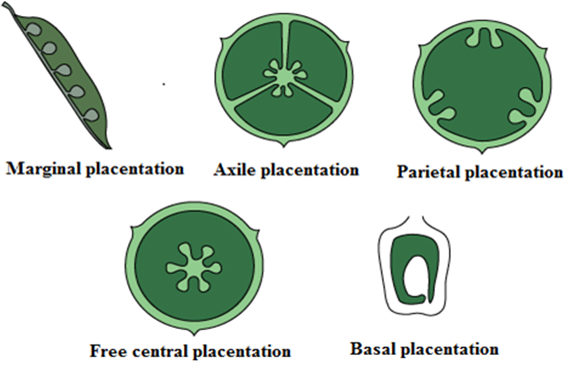
What is a flower? Describe the parts of a typical angiosperm flower
Flower is a modified shoot. It is the reproductive unit of the plant. It is the means of sexual reproduction.
A typical flower
Each flower usually has four whorls arranged successively on the swollen end of the receptacle called the thalamus. The parts of a typical flower are :
i. Calyx – It forms the outermost whorl of a flower and contains sepals. Sepals are green, leaf-like structures that cover and protect the flowers during the bud stage. When the sepals of a flower are free, they are called polysepalous, when fused sepals they are called gamosepalous.
ii. Corolla – It is the layer that lies inside the calyx. It contains petals which brightly coloured and help in attracting insects for pollination. When the petals are free, they are called polypetalous, while fused petals are called gamopetalous. Shape of corolla varies in different plants and may tubular. Bell shaped, funnel shaped or wheel shaped.
iii. Androecium – It is the male reproductive part of a flower. It is composed of stamens. A stamen has a stalk or filament and an anther. Each anther is bilobed, with each lobe having two chambers called the pollen sacs. The pollen sacs have the male gamete or the pollen grains.iv. Gynoecium - represents the female reproductive part of a flower. It is made up of carpels. A carpel is made up of three parts namely stigma style and ovary.Ovary is the enlarged part at the base. The ovary is connected by a long tube called style. The stigma is usually the sticky tip at the end of the style. Each ovary bears one or many ovules attached to the placenta.
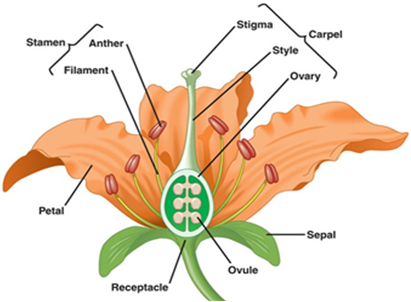
How do the various leaf modifications help plants?
The benefits of the different modification of the leaves in plants are:
(a) Tendrils: Tendrils are found in pea plant and help the plant in climbing.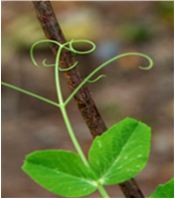
(b) Spines: The leaves in cactus are modified into sharp spines that protect the plant and act as a defence organ.
(c) Storage: The leaves of onion become fleshy and help in the storage of food in plants. 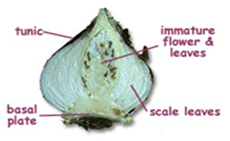
(d) Phyllode - The leaves of some Australian acacia are short-lived and soon replaced by flattened, green structures called phyllodes that arise from the petiole of the leaves. The petioles in these plants synthesize food.
(e) Pitcher - The leaves of the insectivorous plants like pitcher plant are modified into pitcher-like structures, which contain digestive juices and help in trapping and digesting insects.
Define the term inflorescence. Explain the basis for the different types inflorescence in flowering plants.
Inflorescence is the manner in which the flowers are arranged on the flowering axis. During the flowering season, the vegetative apex of the stem gets converted into a floral meristem. Depending on whether the apex gets converted into the flower or continues its growth, inflorescence is classified into racemose and cymose.
(i). Racemose inflorescence: In this the floral axis(main axis) continues to grow and produces flowers laterally. The flower are borne in acropetal succession, i.e the new flowers are at the top and the old flowers at the bottom.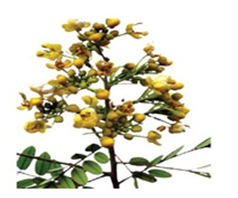
(ii). Cymose inflorescence: The main axis terminates into a flower. Hence, it is limited in growth.The flowers are borne in basipetal order i.e the old flowers are at the top while the new flowers are at the bottom. 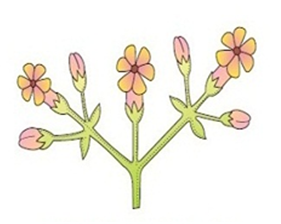
Describe the arrangement of floral members in relation to their insertion on thalamus.
Based on the position of the calyx, corolla, and androecium with respect to the ovary on the thalamus, the flowers can be grouped into three categories that are hypogynous, perigynous, and epigynous.
Hypogynous flowers – In this the ovary occupies the highest position on the thalamus while other floral parts are situated below it. In such flowers, the ovary is superior. e.g., China rose, mustard etc.
Perigynous flowers: The ovary is situated at the centre and other floral parts are arranged on the rim of the thalamus. The ovary here is said to be half inferior. e.g., plum, rose, peach. 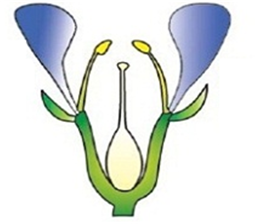

Epigynous flowers: The thalamus grows around the ovary fusing with its wall. The other floral parts are present above the ovary. Hence, the ovary is said to be inferior e.g., flowers of guava and cucumber. 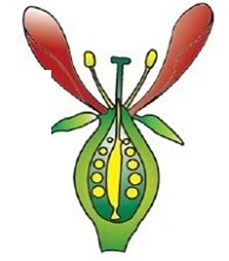
Write the floral formula of a actinomorphic, bisexual, hypogynous flower with five united sepals, five free petals, five free stamens and two united carples with superior ovary and axile placentation.

Where,
Actinomorphic is represented by the symbol:

Calyx by:

Corolla by:

Androecium by:

Gynoecium by:

The mature seeds of plants such as gram and peas, possess no endosperm, because
These plants are not angiosperms
There is no double fertilization in them
Endosperm is not formed in them
Endosperm gets used up by the developing embryo during seed development
D.
Endosperm gets used up by the developing embryo during seed development
Roots developed from parts of the plant other than radicle are called
Taproots
Fibrous roots
Adventitious roots
Nodular roots
C.
Adventitious roots
Venation is a term used to describe the pattern of arrangement of
Floral organs
Flower in inflorescence
Veins and veinlets in a lamina
All of them
C.
Veins and veinlets in a lamina
Name the body part modified for food storage in the following
a. Carrot
b. Colocasia
c. Sweet potato
d. Asparagus
e. Radish
f. Potato
g. Dahlia
h. Turmeric
i. Gladiolus
j. Ginger
k. Portulaca
a. Root
b. Stem
c. Root
d. Root
e. Stem
f. Stem
g. Leaves
h. Stem
i. Root
j. Stem
k.StemRoots obtain oxygen from air in the soil for respiration. In the absence or deficiency of O2, root growth is restricted or completely stopped. How do the plants growing in marshlands or swamps obtain their O2 required for root respiration?
Plants found in the marshlands have root modifications called Pneumatophores which are negatively geotropic that is they come out of the ground and grow vertically upwards to take up oxygen from the atmosphere.
Omprakash used to go to vegetable market with his grandfather, a retired biology teacher.
Grandfather told Omprakash that chilies, brinjal and tomato belong to the same family of plants and asked him to find out similarity in these plants. Read the above passage and answer the following questions:-
I. Identify the family to which these plants belong.
II. What are the characteristic features of the family?
i. Solanaceae
ii. Persistent Calyx, Obliquely Placed Ovary and Swollen Placenta
Sponsor Area
Pointing towards a sunflower plant, the father asked Kailash, a biology student to show him the flower of this plant. Kailash pluck flowering twig and pointed towards the big yellow structure at
the tip of the twig. Father laughed and clarified that it is not a single flower but a group of
several flowers arranged in a disc-like structure. Read the above passage and answer the
following questions:-
I. What is inflorescence?
II. Define racemose and cymose inflorescence?
I. Inflorescence is an axis bearing a cluster of flowers in a particular manner.
II. In the racemose type of inflorescence, the main axis possesses terminal bud which grows indefinitely giving rise to lateral and axillary flowers. In cymose type, the main axis terminates into a flowers and further growth takes place by lateral branches which arises below the terminal flower.
Ishwar was reading a chapter on the function of different parts of a green plant. His mother asked him about the functions of roots. He replied that roots are meant for anchorage and absorbing water and minerals from the soil. Then mother showed him radish, carrot, and turnip and asked him about the additional functions that the roots perform.
Read the above passage and answer the following questions:-
I. What is the special function of roots in above examples?
II. What other secondary functions roots are known to perform?
i. Radish carrot and turnip all are modified for storage of food.
ii. Roots performs the following function:
Support (Stilt root), respiration (pneumatophores), photosynthesis (Trapa).
Give the technical terms for the following
a. A sterile stamen.
b. Stamens are united in one bunch
c. Stamens are attached to Petals.
a. A sterile stamen is known as - Staminode
b. Stamens are united in one bunch - Monodelphous
c. Stamens are attached to Petals - Epipetalous
Distinguish between families fabaceae, solanaceae, liliaceae on the basis of gynoecium characteristics. Also write economic importance of any one of the above family.
| Family | Characteristics of Gynoecium |
| Fabaceae | Monocarpellary, ovary unilocular, marginal placentation |
| Solanaceae | Bicarpellary syncarpous, carpels placed obliquely, bilocular, axile placentation |
| Liliaceae | Tricarpellary, syncarpous, ovary superior, axile placentation |
b. The economic importance of Fabacae.
i. They act as sources of protein. (pulses - gram, arhar)
ii. They used for the production of edible oil like that of soyabean, groundnut etc.
iii. Used for the production of dye (Indigofera)
iv. They provide fibres like the plant sunhemp)
v. They provide fodder (Sesbania, Trifolium)
vi. They are grown as ornamental plants (lupin)
vii. They produce medicine.
The arrangement of ovules within the ovary is known as placentation.
What does the term placenta refer to?
Name the different types of placentation seen in plants.
The placenta is the part of the ovary of a flowering plant to which the ovules are attached.The mode of attachment of ovule to the placenta is known as placentation.
Placentation is of the following types:
(a) Parietal
(b) Marginal
(c) Axile
(d) Free central
(e) Basal.
Tendrils are found in the following plants. Identify whether they are stem
tendrils or leaf tendrils.
a. Cucumber
b. Peas
c. Pumpkins
d. Grapevine
e. Watermelons
a. Stem tendril
b. Leaf tendril
c. Stem tendril
d. Stem tendril
e. Stem tendril
Sunflower is not a flower. Explain
Sunflower is not a flower rather a bunch of flowers. In fact, what appears to be a single flower is, in fact, an inflorescence. this type of inflorescence is called capitulum.
The following features of sunflower prove that it is not a flower but an inflorescence.
i. Receptacle is flattened
ii. Many small and sessile florets on the receptacle.
iii. The youngest florets are at centre while the oldest are at the periphery.
iv. There are two kinds of florets in sunflower, called as the ray florets and disc florets.
v. Ray florets are on the rim of the receptacle. These are of yellow colour.
vi. Disc florets are present in the centre. They are bisexual and actinomorphic.
Tendrils of grapevines are homologous to the tendril of pumpkins but are analogous to that of pea. Justify the above statement.
Both the tendrils of grapevine are homologous to the tendril of pumpkin are modified stem that is they have a common origin but perform different functions. Thus they are homologous to each other.
However, the tendrils of pea are the modification of leaves but perform the same function as the tendrils of the grapevine and thus are called analogous organs.
Rhizome of ginger is like the roots of other plants that grows underground. Despite this, ginger is a stem and not a root. Justify.
Rhizome shows the following properties which classify it as a modified stem and not root:
i. The presence of scaly leaves
ii. The presence of node and internodes
iii. The presence of adventitious roots.
Differentiate between
a. Bract and Bracteole
The leaf-like structures in the axil are called bract. Whereas bracteole is borne on the stalk of the flower.
Differentiate between
b. Pulvinus and petiole
The leaf stalk is called petiole while the swollen portion of the leaf base is called pulvinus.
Differentiate between
c. Pedicel and peduncle
Pedicel is the stalk of the flower while the peduncle is the stalk of the whole inflorescence.
Differentiate between
d. Spike and spadix
Spike - Inflorescence composed of the main axis and laterally borne flowers with no pedicel.
Spadix - Inflorescence composed of flowers with no pedicel, all embedded in an elongated ovoid receptacle.
Differentiate between
e. Stamen and staminode
Stamen is the male reproductive organ in flower.
Staminode is the sterile stamen.
Differentiate between
f. Pollen and pollenium
Pollen is the male gamete in a flower, whereas pollenium is the coherent mass of pollen grains in a plant that is the product of only one anther
Tricarpellary, syncarpous gynoecium is found in flowers of
-
Solanaceae
-
Fabaceae
-
Poaceae
-
Liliaceae
D.
Liliaceae
Liliaceae ga G3 condition
Cotyledon of maize grain is called
-
coleorhiza
-
caleoptile
-
scutellum
-
plumule
C.
scutellum
Large, shield-shaped cotyledon of a grass family is called scutellum.
Coleorhiza is a sheath protecting the root germinating grass.
Coleoptile is a sheath covering emerging shoot. Plumule is a rudimentary shoot of an embryo plant.
Which of the following is not a stem modification?
-
thorns of citrus
-
tendrils of cucumber
-
Flattened structures of Opuntia
-
Pitcher of Nepenthes
D.
Pitcher of Nepenthes
Pitcher of nepenthes is a modification of the leaf.
Stems modified into flat green organs performing the functions of leaves are known as
-
phyllodes
-
phylloclades
-
scales
-
cladodes
B.
phylloclades
Phylloclades are aerial modified stem, in which stem becomes thick, fleshy succulent, green and perform the function of photosynthesis. The leaves are reduced to spines in this.
The standard petal of papilionaceae corola is also called
-
pappus
-
vexillum
-
corona
-
carina
B.
vexillum
The large upper petal in Papilionaceae is known as vexillum.
Among bitter gourd mustard, brinjal, pumpkin, China rose, lupin, cucumber, sunn hemp, gram, guava, bean, chilli, plum, Petunia, potato tomato, rose, With potato, onion, aloe and tulip, how many plants have hypogynous flower?
-
Six
-
Ten
-
Fifteen
-
Eighteen
C.
Fifteen
|
|
Flowers |
|
|
Hypogynous |
Perigynous |
Epigynous |
|
Gynoecium present above all the floral parts Ovary is superior |
Gynocecium present in the centre. Other part almost at same level. Ovary half inferior, e.g., Plum,rose |
Ovary enclosed by thalamus and gets fused with it Other parts above ovary Ovary inferior e.g., Guava, cucumber. |
Pulm, rose are perigynous and guava, cucumber are epigynous. So, total remaining plants are hypogynous.
In China rose the flowers are
-
actinomorphic, hypogynous with twisted aestivation
-
actinomorphic, epigynous with valvate aestivation
-
zygomorphic, hypogynous with imbricate aestivation
-
zygomorphic, epigynous with twisted aestivation
A.
actinomorphic, hypogynous with twisted aestivation
Actinomorphic (star-shaped) can be divided into 3 or more identical sectors, which are related to each other by rotation about the centre of the flower, e.g., china rose. Zygomorphic flowers can be divided by only a single plane into two mirror-image halves., e.g., orchids.
Valvate aestivation: The sepals or petals in whorl just touch one another at the margin, e.g., Calotropis.
Twisted aestivation: One margin of the appendage overlaps that of the next one, e.g., china rose. Imbricate aestivation the margins of sepals or petals overlap but not necessarily in a specific direction. e.g cassia.
Seed coat is not thin, membranous in
-
maize
-
coconut
-
groundnut
-
gram
B.
coconut
The seed coat is thick in coconut seed and thin, membranous in groundnut, gram and maize seeds.
The wheat grain has an embryo with one large, shield-shaped cotyledon known as
-
Epiblast
-
Coleorrhizia
-
Scutellum
-
Coleoptile
C.
Scutellum
The grain of wheat, maize or rice is a caryopsis. The embryo in such grains lies laterally near the base of the grain. The embryo consists of an upper large, shield-shaped cotyledon known as scutellum. The scutellum is closely pressed against the endosperm and helps in the translocation of nutrients from endosperm to the growing embryo at the time of germination and seedling growth.
An example of edible underground stem is
-
carrot
-
groundnut
-
sweet potato
-
potato
D.
potato
Potato (Solanum tubersosum) is an edible underground stem which becomes fleshy and tuberous as a result of food storage.
Among china rose, mustard, brinjal, potato, guava, cucumber, onion and tulip, how many plates have superior ovary?
-
Five
-
Six
-
Three
-
Four
B.
Six
A superior ovary is an ovary attached to the receptacle above the attachment of other floral parts. In this case the flower is said to be hypogynous.e.g., China, rose, mustard, brinjal, potato, onion and tulip. Guava and cucumber have inferior ovaries or epigynous flowers.
So, out of 8 given names, 6 have superior ovaries.
Male gametophyte with least number of cell is present in
-
Pteris
-
Funaria
-
Lillium
-
Pinus
C.
Lillium
Lilium (angiosperm) possesses the male gametophyte with least number of cells. The number of cells in male gametophyte shows the pattern of reduction from bryophytes to angiosperms. In angiosperms, it is reduced to about 2-3 celled and called as pollen grains.
Pollen grains are produced by meiosis of microspore mother cells that are located along the inner edge of the anther sacs (microsporangia).
The number of cells in male gametophyte decreases in the following order.
Funaira > Pteris > Pinus > Lilium
An aggregate fruit is one which develops from
-
multi carpellary syncarpous gynoecium
-
Multi carpellary apocarpus gynoecium
-
complete inflorescence
-
multi carpellary superior ovary
B.
Multi carpellary apocarpus gynoecium
Aggregate fruits of etecrio are those fruits that develop from the merger of multiccarpelllary apocarpus gynoecium ( ovary). In contrast, a simple fruit develops from one ovary, Aggregate fruit may also be called accessory fruits in which part of the flower and form part of the fruit, e,g., raspberry, etc.
Placentation in tomato and lemon is
-
parietal
-
free central
-
marginal
-
axile
D.
axile
Lemon or Citrus (Family-Rutaceae), tomato or Lycopersicon sp. (Family-Solanaceae), China rose or Hibiscus (Family Malvaceae) etc. have axile placentation. It occurs in multi carpellary, syncarpous ovary. Inward growth of margins of carpels forms a multi carpellary condition which contains an axis in the centre. Placentae arise from this central axis which bear ovules.
Cymose inflorescence is present in
-
Solanum
-
Sesbania
-
Trifolium
-
Brassica
D.
Brassica
Cymose inflorescence is also called definite or determinate inflorescence because the growing point of the peduncle is used up in the formation of a flower. Further growth of the flowering axis is continued by ove or more lateral branches (peduncles) which also end in flowers. This type of inflorescence is found in family-Solanaceae.
Phyllode is present in
-
Asparagus
-
Euphorbia
-
Australian Acacia
-
Opuntia
C.
Australian Acacia
The lamina in compound leaves of some plants fall off soon and petiole get modified into sickle-shaped leafy structure which performs photosynthesis. Such a modified petiole is called phyllode. Phyllodes develop usually vertically and possess fewer stomata hence, reduce transpiration, e.g. Australian Acacia, Parkinsonia, etc.
The gynoecium consists of many free pistils in flowers of
-
Aloe
-
tomato
-
Papaver
-
Michelia
D.
Michelia
Apocarpous condition arises when the number of carpels is two or more and they are free from each other. e.g., Clematis, Michelia (Magnoliaceae), Aconitum, Ranunculus (Buttercup), etc.
Which one of the following is correctly matched?
-
Onion – Bulb
-
Ginger – Sucker
-
Chlamydomonas – Conidia
-
Yeast – Zoospores
A.
Onion – Bulb
Onion is a simple tunicated layered bulb while ginger is a straggling rhizome having uniparous cyme branching with sympodial axis.
How many plants in the list given below have composite fruits that develop from an inflorescence?
Walnut, poppy, radish, fig, pineapple, apple, tomato, mulberry
-
Four
-
Five
-
Two
-
Three
D.
Three
| S.No. | Plant | Botanical Name | Fruit | Inflorescence |
| 1 | Fig | Ficus carcia | Syconus | Hypanthodium |
| 2 | Pineapple | Annanas sativus | Sorosis | Spike |
| 3 | Mulberry | Morus sp | Sorosis | Catkin |
Vexillary aestivation is characteristic of the family
-
Fabaceae
-
Asteraceae
-
Solanaceae
-
Brassicaceae
A.
Fabaceae
Vexillary aestivation of corolla is a characteristic of family - Papilionaceae in which corolla (petals) are papilionaceous. In papilionaceous corolla, the posterior petal called vexillum is largest, two lateral, curved petals are called wings and two anterior, boat-shaped petals are called keels.
Which one of the following organisms is correctly matched with its three characteristics?
-
Pea: C3 pathway, Endospermic seed, Vexillary aestivation
-
Tomato: Twisted aestivation, Axile placentation, Berry
-
Onion: Bulb, Imbricate aestivation, Axile placentation
-
Maize: C3 pathway, Closed vascular bundles, Scutellum
B.
Tomato: Twisted aestivation, Axile placentation, Berry
Pea-C3-pathway, non-endospermic seed, vexillary aestivation.
Tomato-Twisted aestivation, axile placentation, berry fruit.
Maize -C4- pathway, closed vascular bundle.
Onion-Bulb, axile placentation, perianth.
How many plants in the list given below have marginal placentation?
Mustard, Gram, Tulip, Asparagus, Arhar, Sun hemp, Chilli, Colchicine, Onion, Moong, Pea, Tobacco, Lupin
-
Four
-
Five
-
Six
-
Three
C.
Six
| Placentation | Example |
| Axile | Tomato, onion, Asparagus, tobacco, chilli, tulip, colchicine |
| Parietal | Mustard |
| Marginal | Gram, arhar, moong, pea, lupin, sunhemp |
Plants with ovaries having only one or a few ovules, are generally pollinated by
-
Bees
-
Butterflies
-
Birds
-
Wind
D.
Wind
The transfer of pollen grains from anther to stigma is called pollination. Anemophily is a mode of pollination accomplished through wind, while entomophily is the mode of pollination, accomplished by insects like moth, butterflies, wasps, bees, etc. The plants with ovaries having only one or a few ovules are generally pollinated by wind but sometimes by insects.
Which one of the following shows isogamy with non-flagellated gametes?
-
Sargassum
-
Ectocarpus
-
Ulothrix
-
Spirogyra
D.
Spirogyra
Isogamy with non-flagellated of gametes is seen is Spirogyra can reproduce both by sexual and asexual (vegetative) means.
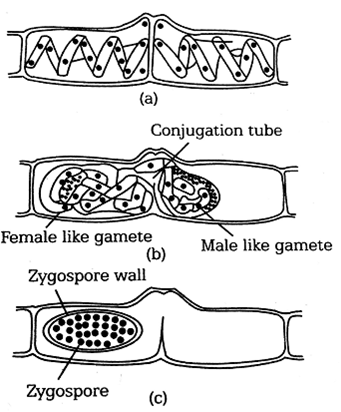
They reproduce sexually by conjugation in which two non-flagellated morphologically similar but physiologically different gametes (isogamous) fuse together. One filament acts male like gamete and passes through the conjugation tube of another filament which acts as a female like a gamete.
When the margins of sepals or petals overlap one another without any particular direction, the condition is termed as
-
vexillary
-
imbricate
-
twisted
-
valvate
B.
imbricate
Imbricate aestivation is the arrangements five petals being arranged in such a way that one petal is completely external and being another petal is completely internal, while three petals are partially external and partially internal,
e.g, Cassia, Callistemon and Caesalpinia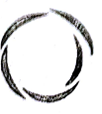
Sponsor Area
Cuscuta is an example of
-
ectoparasitism
-
brood parasitism
-
predation
-
endoparasitism
A.
ectoparasitism
Cuscutta (Amarbel) is a total stem parasite that grows on a number of plants like - Citrus, Duranta, Zizyphus, etc. It sends a number of haustoria into the host. Xylem and phloem of haustorium make connection with sap and food channel of host.
Predation is an interaction in which member of one species capture, kill and eat up member of Endoparasite lives inside the host body.
 is the floral formula of
is the floral formula of
-
Allium
-
Sesbania
-
Petunia
-
Brassica
Allium
Sesbania
Petunia
Brassica
C.
Petunia
Floral formula is of Solanaceae family, i.e. of Petunia, while Brassica is form Brassicaceae whereas, Allium belongs to Liliaceae and Sesbania is from Fabaceae family.
As characteristic features of Solanaceae are
(i) Inflorescence - Cymose
(ii) Flower - Ebracteate, actinomorphic, bisexual, pedicellate.
(iii) Calyx - Sepals 5, gamosepalous, valvate aestivation.
(iv) Corolla - Petals 5, twisted or valvate aestivation
(v) Androecium - Stamens 5, epipetalous.
(vi) Gynoecium - Bicarpellary, syncarpous, axile placentation, superior ovary and bilocular, which is represented as floral formula.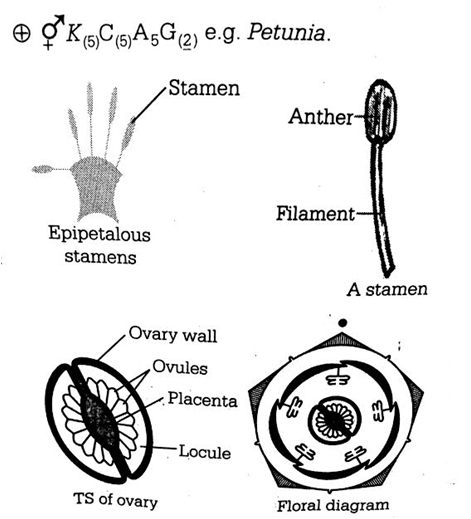
Keel is the characteristic feature of flower of
-
Tulip
-
Indigofera
-
Aloe
-
Tomato
B.
Indigofera
Keel is petal is vexillary aestivation, which is a characteristic of family - Fabaceae, i.e. Indigofera tomato belongs to family - Solanaceae, tulip and while aloe to Liliaceae.
Papilionaceae (e.g. Indigofera, pea) is sub-family of Fabaceae, which has bilateral symmetry with corolla consist of 5 petals. It follows vexillary aestivation. A single upper posterior petal is known as banner. Two lateral compressed petals called wings and a pair of anterior small fused petal forms keel. Keel has concave sides which make them fused at bases. 
Hence, keel is the characteristic feature of flower of family - Papilionaceae. e.g. Indigofera.
Perigynous flowers are found in
-
guava
-
cucumber
-
China rose
-
rose
D.
rose
Perigynous flower are found in rose.
Flowers can be categorised based on the position of the ovary in relation to the other parts of the flower. When the floral parts arise from a position below the ovary, the flower is said to be hypogynous (hypo = below; gynous = flower) and the ovary is superior, e.g. China rose.
When the floral parts arise from a position above the ovary, the flower is epigynous (epi = above) and ovary is inferior, e.g. cucumber and guava.
There is another special case of an inferior ovary where the bottom of sepals. petals and stamens are fused into a cup around the ovary called hypanthium (floral cup). Such, flower is termed as perigynous (peri = around), e.g. rose.
Leaves become modified into spines in
-
Opuntia
-
pea
-
onion
-
silk cotton
A.
Opuntia
Leaves are modified into spines in Opuntia (xerophytes) so as to reduce the surface area and minimize rate of water loss by evaporation and transpiration. Besides, they also provide protection to the plant from grazing animals.
In pea, the leaves are modified into tendrils to help them in climbing around support, in onion leaves are modified to fleshy succulent to store food.
The hilum is a scar on the
-
seed, where funicle was attached
-
fruit, where it was attached to pedicel
-
fruit, where style was present
-
seed, where micropyle was present
A.
seed, where funicle was attached
The hilum is a scar(mark) on the seed, produced by separation from its funicle or placenta. The point of attachment of the body of the ovule (later which form seed) with the funicle is known as hilum.
The hilum is a scar on the
-
seed, where funicle was attached
-
fruit, where it was attached to pedicel
-
fruit, where style was present
-
seed, where micropyle was present
A.
seed, where funicle was attached
The hilum is a scar(mark) on the seed, produced by separation from its funcile or placenta. The point of attachement of the body of the ovule (later which forms seed) with the funicle is known as hilum.
Flowers are zygomorphic on
-
Gulmohur
-
tomato
-
datura
-
mustard
A.
Gulmohur
When a flower can be divided into two similar halves only in one particular vertical plane, it is called zygomorphic, e.g., bean, pea Gulmohur, cassia etc.
The ovary is half inferior in flowers of
-
cucumber
-
cotton
-
guava
-
peach
D.
peach
If gynoecium is situated in the centre and other parts of the flowers are located on the rim of the thalamus almost at the same level, it is called perigynous. The ovary here is said to be half inferior, i.e, plum rose, peach, etc.
Whorled, simple leaves with reticulate venation are present in
-
Calotropis
-
Neem
-
China rose
-
Alstonia
D.
Alstonia
If more than two leaves arise at a node of stem and its branches and form a whorl, the phyllotaxy is said to be whorled as in Alstonia Nerium etc. In Alstonia five leaves are present in a whorl while in Nerium three leaves are present in a whorl
Which one of the following diagrams represents the placentation in Dianthus?
B.

When the ovules are borne on the central axis and septa are absent as in Dianthus and Primerose, the Placentation is called central.
In unilocular ovary with a single ovule, the placentation is
-
marginal
-
basal
-
free central
-
axile
B.
basal
In basal placentation, the ovary is bicarpellary, syncarpous and unilocular and a single ovule is borne at the base of ovary, eg, marigold.
In marginal placentation, the ovary is simple unilocular and the ovules are arranged along the margin of ovary eg, pea.
Ovary is half -inferior in the flowers of
-
guava
-
plum
-
brinjal
-
cucumber
B.
plum
If gynoecium is situated in the centre and other parts of the flower are located in the rim of the thalamus almost at the same level, it is called a perigynous flower. The ovary here is said to be half inferior., eg, plum rose peach.
Coiling of garden pea tendrils around any support is an example of
-
thigmotaxis
-
thigmonasty
-
thigmotropism
-
thermotaxis
C.
thigmotropism
Thigmotropism movements are due to contact with a foreign body. In twiners and lianas, there is less growth of the idea of contact and more growth on the side of branch away from the contact. Coiling of garden pea tendrils around any support is an example of thigmotropism
Which one of the following is a xerophytic plant in which the stem is modified into the flag green and succulent structure?
-
Opunita
-
Casuarina
-
Hydrilla
-
Acacia
A.
Opunita
opuntia is a plant growing in dry and xeric habitats.In this, the stem, having several nodes and internodes is modified into flat, fleshy, thick green, leaf-like structure called phylloclades. Phylloclade performs the function of photosynthesis like a leaf and also stores food leaves get modified into spines which help to reduce transpiration.
The floral formula ![]() is that of
is that of
-
tulip
-
soybean
-
sun hemp
-
tobacco
D.
tobacco
Tobacco belongs to the family- Solanaceae. It's floral formula is
Anatomically fairly old dicotyledonous root is distinguished from the dicotyledonous by
-
the absence of secondary xylem
-
the absence of secondary phloem
-
the presence of cortex
-
the position of protoxylem
D.
the position of protoxylem
In dicotyledonous root, the condition of xylem is exarch as the protoxylem away from the centre and metaxylem onwards the centre. In dicotyledonous stem (eg, Cucubita), the condition of xylem is endarch as the metaxylem away from the centre and protoxylem towards the centre.
An example of axile placentation is
-
Argemone
-
Dianthus
-
Lemon
-
Marigold
C.
Lemon
Lemon (citrus sp. ) belongs to family Rutaceae, contains axile placentation.
Argemone belongs to family-Papaveraceae, contains parietal Placentation. Dianthus belongs to family-Caryophyllaceae, contains free central placentation. Marigold belongs to family-Asteraceae, contains basal placentation.
A fruit developed from hypanthodium inflorescence is called
-
hesperidium
-
sorosis
-
syconus
-
caryopsis
C.
syconus
Syconus fruit develops from the hypanthodium inflorescence, eg, Ficus carica, F. religiosa, F. benghalensis. The flask-shaped receptacle encloses female flowers that give rise to achene-like fruitless. This fruit possesses a small pore protected by scaly leaves. The receptacle that becomes fleshy is edible.
The correct floral formula of soybean is
C.
Soybean or Glycine max is a member family Fabaceae, subfamily-phpilionidae. Its floral formula is![]()
Dry indehiscent single-seeded fruit formed from bicarpellary syncarpous inferior ovary is
-
Caryopsis
-
cypsela
-
Adiantum
-
Equisetum
B.
cypsela
Cypsela is dry, indehiscent, single-seeded fruit develops from an unilocular, single ovulate inferior ovary of bicarpellary, syncarpous, gynoecium possessing basal placentation. The fruit wall develops from pericarp and thalamus and is thin and remains attached to the seed at one point, eg, Helianthus.
Caryopsis are dry, indehiscent, the small single-seeded fruit develops from unilocular single ovule, superior ovary of the multi carpellary gynoecium. It differs from typical achenes as their pericarp is completely fused with the seed coat or testa, eg, Poaceae.
Cremocarp is bilocular and two seeded schizocarpic fruits (small, dry) developed from the inferior ovary of bis carpellary, syncarpous gynoecium possessing persistent stylopodium, eg, Apiaceae.
Berry is fleshy, indehiscent, few to multi-seeded fruit derived from multi carpellary syncarpous gynoecium.The fleshy pericarp of berry consists of epicarp. Mesocarp and endocarp.
The fleshy receptacle of syconus of fig encloses a number of
-
achenes
-
samaras
-
berries
-
mericarps
A.
achenes
Syconus is a composite fruit develops from the hypanthodium inflorescence, eg, Ficus carica, Ficus Benghalensis. The flask-shaped receptacle encloses female flowers that give rise to achene - like fruits. This fruit possesses a small pore protected by scaly leaves. THe receptacle that becomes fleshy is edible.
Samara is a single-seeded, dry indehiscent fruit. Its pericarp becomes membranous and flat-like wings that help in dispersal, eg Ulmus Holoptelia indica.
Which one of the following scientist's name is correctly matched with the theory put forth by him?
-
Weissmann-Theory of continuity of germplasm
-
Pasteur - Inheritance of acquired characters
-
de Vries - Natural selection
-
Mendel - Theory of pangenesis
A.
Weissmann-Theory of continuity of germplasm
Pasteur - Germ theory of disease
Charles Darwin - Theory of natural selection
Lamarck- Inheritance of acquired characters.
Weismann -Theory of continuity of germplasm
Hugo de Vries - Mutation theory
Mendel - Laws of inheritance
Darwin - Theory of pangenesis
Which one of the following groups of three animals each is correctly matched with their one characteristic morphological feature?
-
Liver fluke, Sea anemone, Sea cucumber - Bilateral symmetry
-
Centipede, prawn, sea urchin - Jointed appendages
-
Scorpion, spider, cockroach - Ventral solid central nervous system
-
Cockroach, locust, Taenia -Metameric segmentation
C.
Scorpion, spider, cockroach - Ventral solid central nervous system
Bilateral symmetry - Liver fluke, Taenia
Jointed appendages - Prawn, cockroach, scorpion
Ventral solid central nervous system - Scorpion spider, cockroach
Metameric segmentation -Annelids
Radial symmetry - Sea anemone
The fruit is chambered, developed from inferior ovary and has seeds with succulent testa in
-
pomegranate
-
orange
-
guava
-
cucumber
A.
pomegranate
Balausta is a special type of false or Pseudocarpic berry develops from multiocular berry develops from multilocular , syncarpous inferior ovary. The whole fruit is enclosed by hard rind made up of exocarp (epicarp fused with thalamus) and part of mesocarp. Plate - like infoldings are developed by mesocarp. The papery endocarp covers the individual group of seeds. The seeds possess bright red juicy testa form edible part of fruit, eg, pomegranate.
Opening of floral buds into flowers, is a type of
-
autonomic movement of locomotion
-
autonomic movement of variation
-
paratonic movement of growth
-
autonomic movement of growth
D.
autonomic movement of growth
Opening of floral buds into flower is a type of autonomic movement of growth (Nastic movement). This is non-directional movement in which the response is determined by the structure of the responsive organ and not to the direction of stimulus. Greater growth on one side causes the organ to bend to the opposite side.
In which of the following fruits is the edible part the aril?
-
Custard apple
-
Pomegranate
-
Orange
-
Litchi
D.
Litchi
Aril is the edible part in the fruit of litchi. The aril is an accessory seed covering often formed from an outgrowth at the bare of the ovule.
What type of placentation is seen in sweet pea?
-
Basal
-
Axile
-
Free central
-
Marginal
D.
Marginal
In sweetpea (Pisum sativum), the placentation is marginal, in which the placenta develops along the junction of two carpels, in a unilocular ovary. In basal placentation, the ovules are few or reduced to one and are borne at the base of ovary. e.g. compositae.
In axile placentation, margins of carpels fold inwards, fusing together in centre of ovary to form a single central placenta. Ovary is divided into as my locules, as there are carples e.g., Hibiscus, Asphodelus. Free-central placentation possesses a placenta arises as a central upgrowth from ovary base e.g. Stellaria.
Pentamerous, actinomorphic flowers, bicarpillary ovary with oblique septa, and fruit a capsule or berry, are characteristic features of
-
Asteraceae
-
Brassicaceae
-
Solanaceae
-
Liliaceae
C.
Solanaceae
Family Solanaceae possesses pentamerous, actinomorphic, hypogynous, hermaphrodite, complete flowers, bicarpellary, syncarpous, superior, bilocular ovary with axile placentation and oblique septa. The fruit is a berry or septicidal capsule.
In Asteraceae, ovary is bicarpellary, suncarpous, inferior, unilocular and fruit is cypsela.
In Brassicaceae, ovary is bicarpellary, syncarpous, superior, unilocular but later becomes bilocular due to false septum, fruit is siliqua or silicula.
In Liliaceae, flowers are usually trimerous, ovary is tricarpellary, syncarpous, superior, tricolour and fruit is fleshy berry or capsule.
Select the mismatch
-
Pinus – Dioecious
-
Cycas – Dioecious
-
Salvinia – Heterosporous
-
Equisetum – Homosporous
A.
Pinus – Dioecious
Life cycle of Ectocarpus and Fucus respectively are
-
Haplontic, Diplontic
-
Diplontic, Haplodiplontic
-
Haplodiplontic, Diplontic
-
Haplodiplontic, Haplontic
C.
Haplodiplontic, Diplontic
In Bougainvillea thorns are the modifications of
-
Stipules
-
Adventitious root
-
Stem
-
Leaf
C.
Stem
Thorns are hard, pointed straight structures for protection. These are modified stem
Study the following statements and select the option with correct statements.
- Pulvinus leaf base is present in some leguminous plants
- In Eichhornia, the petioles expand becomes green and synthesise food.
- Opposite phyllotaxy is seen in guava.
I and II
I and III
II and III
I, II and III
B.
I and III
Most of the leaves have a swollen leaf base known as pulvinus. Its attachment to the stem is not strong. In guava opposite phyllotaxy is found. In this case, all the pairs of leaves of branch arise in the same plane so that two vertical rows are formed.
In Australian Acacia, petiole gets modified into leaf-like structure and synthesise food. In Eichhornia, petiole becomes spongy and helps in floating.
The material, which arrests cell division, is obtained from
Crocus
Colchicum
Dalbergis
Chysanthomum
B.
Colchicum
Colchicine is an antibiotic drug, which is obtained from Colchicum (family-Liliaceae). It binds to one tubulin molecule an prevents its polymerisation. The depolymerisation of tubulin results in the disappearance of mitotic spindle blocking the cell's mitotic chromosomal division at metaphase and anaphase.
Three floral diagrams are given here. Their respective families are assigned in the answer key. Find out the families to which these diagrams belong to
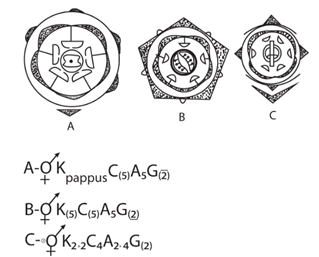
A-Liliaceae, B-Asteraceae, C-Solanaceae
A-Asteraceae, B-Solanaceae, C-BRassicaceae
A-Asteraceae, B-Solanaceae, C-Asteraceae
A-Poaceae, B-Solanaceae, C-Asteraceae
B.
A-Asteraceae, B-Solanaceae, C-BRassicaceae
In Ruscus, the stem is a
Phyllode
Cladode
Offset
Sucker
B.
Cladode
When the stem becomes green, flattened or fleshy and carries out photosynthesis, this is called phylloclade. The short, green, cylindrical or flattened phylloclade with one or two internodes is called cladodes 28., Ruscus.
Catkin inflorescence is found in
Wheat
Oat
Mulberry
Fig
C.
Mulberry
In catkin inflorescence, the flowers are sessile and unisexual with the pendulous axis, e.g., Morus (mulberry).
Epigynous flowers are present in
Mustad
Brinjal
China rose
Cucumber
D.
Cucumber
In the epigynous type of flowers, the thalamus enclosed the ovary entirely and fuses. The sepals, petals and stamens arise from the top of the ovary. Such flowers are known as epigynous and ovary as inferior, e.g., Oenothera, Cucurbita.
In Dianthus, placentation is
Basal
Free central
Axile
Marginal
B.
Free central
In free central placentation, the syncarpous gynoecium is unilocular and the placenta are borne on a central column formed by an extension of the base of the gynoecium where the carpels fuse or the suppression of septa. e.g. Stellaria, Dianthus
Sponsor Area
The term 'keel' is used for special type of
Sepals
Petals
Stamenstellen
Carpels
B.
Petals
Keel is a special type of petal found in the papilionaceous type of Corolla. Papilionaceous type is a butterfly like the Corolla has one large posterior standard, two lateral wings, two innermost and smaller keels.
Coffee and quinine are obtained from the
Leguminosae
Asteraceae
Rubiaceae
Poaceae
C.
Rubiaceae
Coffea arabica (Rubiaceae) yields the well known beverage coffee. Cinchona sp. (Rubiaceae) yields the quinine which is used in the treatment of malaria.
A fern prothallus is bisexual. If fertilisation takes place between their gametes than it is known as
cross- fertilisation
self- fertilisation
isogamous
viviparous
B.
self- fertilisation
Self- fertilisation is the fusion of male and female gametes produced by the same individual.
Cross- fertilisation is the fertilisation of male and female gametes produced by different individuals.
Isogamous is the fusion of isogametes.
Viviparous is a term used for organisms which give birth to young ones.
Chicory powder which is mixed with coffee powder is obtained from
root
leaf
stem
seeds
A.
root
Chicory powder is a flavouring material, whichis mixed with coffee powder. It is obtained from roots of Cichorium intybus of family- Compoistae.
Tea is dried levaes of Thea sinenis.
Ephedrine is obtained from stem of Ephedra gerardiana. It is useful against asthma and as cardiac stimulant.
Stem cuttings are commonly used for the proprogation of
banana
rose
mango
cotton
B.
rose
Stem cuttings are used in Citrus, Cocoa. Rooting of stem cuttings is hastened by dipping in NAA or IBA.
Grafting is usually done in case of mango.
Rhizomes take part in vegetative propogation due to presence of buds, eg, banana, ginger.
Edible part in 'sorosis', a composite fruit, is
cotyledons
endosperm
perianth and peduncle
fleshy thalamus
C.
perianth and peduncle
Sorosis is the composite fruit that develops from spike and catkin, eg, in pineapple edible part develops from perianth and peduncle.
Fleshy thalamus is an edible part of pear, apple fruit, eg, pome fruits.
Cotyledons are edible part of cashewnut, eg, nut fruits.
Endosperm is an edible part of caryopsis of wheat, rice, etc.
Which of the following is a true nut?
Walnut
Cashewnut
Groundnut
Pistachio
B.
Cashewnut
Nut is a fruit which develops from polycarpellary, superior ovary. The pericarp is hard, woody or leathery, eg, edible part of chestnut is cotyledons.
Groundnut is lomentum having seed as an edible part.
Walnut is a drupe fruit having cotyledon as an edible part.
Pistachio is a drupe having seed as an edible part.
Botanical name of 'chana' is
Cicer arietinum
Phaseolus aureus
Lablab purpureus
Dolichos
A.
Cicer arietinum
| Botanical Name | Common Name | Family |
| Cicer arietnum | Gram | Papillionaceae |
| Phaseolus aureus | Green gram | Papillionaceae |
| Dolichos lablab | Sem | Papillionaceae |
An obligate root parasite is
Rafflesia
Loranthus
Viscum
Striga
A.
Rafflesia
Obligate parasites are organisms that obtain their food from host throughout their life, eg, Rafflesia, Orobanche (root parasite).
Facultative parasites are organism which are parasitic but can obtain their food from dead organic matter under certain conditions.
Obligate root parasite Rafflesia, Orobanche etc
Partial root parasite Viscum, Loranthus etc
Obligate stem parasite Santalum
Partial stem parasite Cuscuta
Lady finger belongs to family
Malvaceae
Cucurbitaceae
Liliaceae
Brassiaceae
A.
Malvaceae
| Member | Botanical Name | Family |
| Lady finger | Abelmoschus esculentus | Malvaceae |
| Cucumber | Cucumis sativus | Cucurbitaceae |
| Onion | Allium cepa | Lilaceae |
Pappus is modified
calyx
corolla
bracts
gynoecium
A.
calyx
The pappus is the modifed calyx, the part of an individual floret that surrounds the base of the corolla tube in flower heads of the plant Asteraceae. It basically functions as a parachute for the dispersal of- eg, Sonchus, Tagstes. Hence the mechanism is parachute mechanism.
Trimerous flower, superior ovary and axile placentation is characteristics of
Liliaceae
Cucurbitaceae
Solanaceae
Compositae
A.
Liliaceae
Family- Liliaceae is a monocot family and is characterised by trimerous flowers, fibrous roots, parallel venation, superior ovary and axile placentation, eg, onion.
Cucurbitaceae, Solanaceae and Compositae are dicot families characterised by tetra or pentamerous flowers, tap roots and reticulated venation of leaves.
Clinging roots are found in
orchids
Trapa
Podostemon
screwpine
A.
orchids
Clinging roots are found in orchids. They grow as epiphytes upon the trunks or branches of trees. They hang freely in the air and absorb atmospheric moisture using velaman (modification of epidermis).
Expanded green stem of Opuntia is called
phylloclade
tendril
bulb
cladode
A.
phylloclade
Phylloclade is a modified stem or branch which may be flat or circular, fleshy, like green leaf, eg Opuntia.
Most of the economically important fibre yielding plants belong to family
Malvaceae
Solanaceae
Cruciferae
Paceae
A.
Malvaceae
Most of the economically important fibre yielding plants belong to Family- Malvaceae, for eg, Gossypium, Hibiscus, Cannabinus etc.
The fibre yielding plants are important for human being as they provide clothing. The flax was cultivated in Europe since time immemorial.
Ginger is an underground stem. It is distinguished from root because
it lacks chlorophyll
it stores food
it has nodes and internodes
it has xylem and vessels
C.
it has nodes and internodes
Underground stems can be differentiated from roots by
(i) Absence of root cap
(ii) Absence of root hair
(iii) Presence of terminal bud
(iv) Presence of nodes and internodes
(v) Occurrence of foilage or scale leaves on the nodes.
Floral formula of k5 C5 A5+5 G1 is characteristic of the family
Papilionaceae
Caesalpinoideae
Cruciferae
Mimosoideae
B.
Caesalpinoideae
In the floral formula, Br stands for bracteate K stands for calyx , C for corolla, P for perianth, A for androecium and G for Gynoecium, G for superior ovary and G for inferior ovary, for male, for female , for bisexual plants, ⊕ for actinomorphic and for zygomorphic nature of flower.
The member of sub-family Caesal pinieae have bracteate, zygomorphic, bisexual, hypogynous, pentamerous flowers with 5-sepals (polysepalous) 5-petals (polypeptalous), 5 +5 stamens (polyandrous) and monocarpellary, superior ovary with marginal placentation.
The number of female flowers found in a cyanthium is
one
three
two
many
A.
one
Cyanthium is a special type of inflorescence (found in Euphorbia sp.) with a cup shaped involucre having nector secreting glands, a centrally placed single large female flower which is reduced to pistil surrounded by many male flowers present in the form of stamens.
In turnip, 2/3 part of swollen area is derived from
hypophysis
hypocotyl
epicotyl
radicle
B.
hypocotyl
In turnip, napiform root is found, the swollen part of which is derived from the hypocotyl.
Which of the following represents the edible part of the fruit of litchi?
Pericarp
Mesocarp
Juicy aril
Endocarp
C.
Juicy aril
The edible part of the fruit of litchi is juicy aril. Aril is an accessory seed covering formed by an outgrowth at the base of the ovule.
Pericarp is the part of a fruit formed from the wall of the ripened ovary.
Mesocarp is the middle layer of the pericarp of a fruit, between the endocarp and the exocarp.
Endocarp is the innermost layer of the pericarp which surrounds a seed in a fruit. It may be membranous or woody.
Commercial cork is obtained from
Flax
Juglans regia
Hevea brassiliansis
Quercus suber
D.
Quercus suber
The 'cork' of commerce is obtained from Quercus suber. The first formed periderm, called virgin cork is removed when the tree is just 20 years old.
The given formula belong to
Solanaceae
Malvaceae
Graminae
Compositae
B.
Malvaceae
The family Malvaceae includes 75 genera and 1000 species. They are found in tropical and subtropical region of the world. The floral fomula is of malva plant.
Biologically most resistant plant material is
sporopollenin
cutin
lignin
suberin
A.
sporopollenin
Sporopollenin is biologically most resistant plant material and is present in pollen exine. It is contributed by the tapetum layer of the another wall.
Select the option that contains all plants which produce non-endospermic seeds.
Gram, Pea, Bean, Groundnut
Castor, Peanut, Orchid, Wheat
Coconut, Walnut, Wheat, Gram
Castor, Maize, Coconut, Orchid
A.
Gram, Pea, Bean, Groundnut
Non-endospermic seeds or exalbuminous seeds have no residual endosperm as it is completely consumed during embryo development. Gram, pea, bean and groundnut have non-endospermic seeds
Gerdy fibres are
ligament of neck
ligament of ankles
ligament of palm
ligament of face
C.
ligament of palm
Gerdy fibres are the superficial transverse ligament of the palm.
Assertion: Black rust of wheat is a hazardous disease which is caused by Puccinia fungus.
Reason: Aflatoxin is produced in the groundnut by the infection of a bacterium.
If both assertion and reason are true and reason is the correct explanation of assertion.
If both assertion and reason are true but reason is not the correct explanation of assertion.
If assertion is true but reason is false.
If both assertion and reason are false.
C.
If assertion is true but reason is false.
Stem rust, also known as black stem rust is caused by Puccinia graminis tritici, a fungus. It primarily infects wheat, but also causes minor infections on cultivars of barley and rye. Groundnut production is reduced by Aspergillus species, a fungus, which causes quantitative losses and produces highly toxic and carcinogenic chemical substance known as aflatoxins
Which of the following is the correct floral formula for the floral diagram given below?
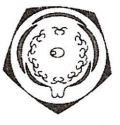
C.

The given floral diagram is of Family Fabaceae. Flower - zygomorphic, bisexual. Sepals -five, fused. Petals - five, polypetalous, papillionaceous corolla. Androecium - ten, diadelphous. Gynoecium - ovary superior, monocarpellary, unilocular, marginal placentation, with many ovules.
Assertion : Storage of seeds at low temperature is possible.
Reason : Respiration and anzymatic activity of seeds are very high at low temperature.
If both assertion and reason are true and reason is the correct explanation of assertion
If both assertion and reason are true but reason is not the correct explanation of assertion.
If assertion is true but reason is false
If both assertion and reason are false
C.
If assertion is true but reason is false
Seeds can last from a few years to centuries, depending on the species and the storage conditions. In general, most seeds stored in cool, dry conditions will survive longer than seeds stored in a wet, warm environment. This is because due to low moisture content and low temperature as it helps in reducing the seed viability.
Assertion : Presence of pneumatophores is a special adaptation of hydrophytes.
Reason : Pneumatophores are positively geotropic shoots that have lenticels and help in gaseous exchange.
If both assertion and reason are true and reason is the correct explanation of assertion
If both assertion and reason are true but reason is not the correct explanation of assertion
If assertion is true but reason is false
If both assertion and reason are false
D.
If both assertion and reason are false
Pneumatophore is an aerial root specialized for gaseous exchange. Hydrophytes are aquatic plants that are especially suited for living in aquatic environments. In order to survive, a hydrophyte, also known as an aquatic macrophyte, must either be completely submerged in water or in some cases be allowed to float on the surface of the water.
Match Column- I with Column - 2 and choose the correct option from below.
| Column - I | Column - II |
| A. Marginal placentation | (i) Sunflower |
| B. Axile placentation | (ii) Mustard |
| C. Parietal placentation | (iii) Lemon |
| D. Basal placentation | (iv) Pea |
A-(iv), B - (iii), C- (ii), D- (i)
A -(iv), B- (iii), C- (i), D - (ii)
A-(iv), B-(i), C- (ii), D - (iii)
A - (iii), B- (iv), C- (ii), D - (i)
A.
A-(iv), B - (iii), C- (ii), D- (i)
| Column - I | Column - II |
| Marginal placentation | Pea |
| Axile placentation | Lemon |
| Parietal placentation | Mustard |
| Basal placentation | Sunflower |
A person who is trisomic for twenty first pair of chromosome suffers from
Klinefelter's syndrome
Down's syndrome
Turner's syndrome
None of the above
B.
Down's syndrome
Down's syndrome(45 + XXor45 + XY) is the case when there is one extra chromosome in 21st pair of autosome. It is also called trisomy 21 or trisomy-G. It is most common in children of over aged mothers (above 41 years). It is also called Mongolian syndrome.
In which blood group antigen are absent
O
A
B
AB
A.
O
Person with blood group 'O' has no antigen on his RBC but has both the antibodies (i.e., a and b) in his plasma. Whereas a person with blood group 'AB' has both antigens but no antibody. Due to this blood group 'O' is universal donor and blood group 'AB' is universal acceptor.
Which of the following is true?
Umbel is a racemose inflorescence where all stalked flower aggregate on the flat receptacle
Raceme is a racemose inflorescence having main axis shortened & flower born acropetally
Spadix is a racemose inflorescence having pendulous spike with main axis much flattened.
Spike is a racemose inflorescence having sessile flowers
D.
Spike is a racemose inflorescence having sessile flowers
Spike is a racemose inflorescence that bears sessile flowers in an acropetal fashion, e.g., chaff flower (Achyranthes), bottle brush (Callistemon), Adathoda vasica, Amaranthus.
The branched sclereids present in hydrophytes are
osteosclereids
trichosclereids
macrosclereids
astrosclereids
D.
astrosclereids
Sclereids are highly thickened dead sclerenchyma cells with very narrow cavities. They may also be branched. They provide stiffness to the parts in which they occur. It is of many types : brachysclereids, macrosclereids, osteosclereids, astrosclereids, trichosclereids and filiform sclereids.
Astrosclereids are star-shaped, having various branches or arms. They are found in intercellular spaces of leaves and stems of many hydrophytes like Nymphaea.
Osteosclereid is the sclereid forming the hypodermal layer in many fruits and seeds. It also occurs in the leaves of certain xerophytes.
Trichosclereids are hard needle like branched cells found in some species of plants that serve the purpose of protecting the plant from herbivores.
Macrosclereid is one of the columnar sclereids that often form an outer layer in various fruits and seeds and also occur in the stems of some plants.
Cut surfaces of fruit and vegetables often become dark because
dirty knife makes it dark
oxidation of tannic acid in the presence of trace of iron from the knife makes it dark
dust of the air makes it dark
none of the above.
B.
oxidation of tannic acid in the presence of trace of iron from the knife makes it dark
When fresh fruits and vegetables are peeled or cut open, the enzyme called polyphenol oxidase (also called tyrosinase) contained in the cells is exposed to and reacts with the oxygen in the air. The reaction that occurs, which is called oxidation, is what turns the fruits and vegetables brown.
Ectophloic siphonostele is found in
Osmunda and Equisetum
Marsilea and Botrychium
Adiantum and Cucurbitaceae
Dicksonia and Maidenhair fern.
A.
Osmunda and Equisetum
Stele is a column containing vascular tissues which is surrounded by pericycle and separated from ground tissue by endodermis. Siphonostcle is medullated protostele or protostele with a central non-vascular pith. Leaf gaps are absent.
Siphonostelc is of two types: In Ectophloic siphonostele, central pith is surrounded successively by xylem, phloem, pericycle and endodermis. In amphiphloic siphonostele there is a central pith and xylem is surrounded on either side by phloem, pericycle and endodermis. It is found in Osmunda and Equisetum.
Composite fruit develops from
single ovary
inflorescence
apocaropous ovary
pericarp
B.
inflorescence
Composite fruits are those fruits which develop from the entire inflorescence rather than from single flower. These are basically of two types: Sorosis and Syconus.
Spike, spadix and catkin type of inflorescence gives rise to Sorosis type of fruit. eg, Ananas.
Syconus develops from a hypanthodium inflorescence. eg Ficus.
Cocoa is the plant from which chocolate is made. Which part is used to extract it?
Flower
Fruits
Seeds
Bark
C.
Seeds
Cocoa or Theobroma belongs to family Sterculiaceae, and is a native of tropical America for preparation of cocoa and chocolates, the seeds are used.
The family containing mustard and its main characters are
Brassicaceae - Tetramerous flowers, six stamens, bicarpellary gynoecium, siliqua type fruit
Brassicaceae - Pentamerous flowers, many stamens, pentacarpellary gynoecium, capsule type fruit
Solanaceae - Pentamerous flowers, five stamens, bicarpellary gynoecium, berry type fruit
Poaceae - Trimerous flowers, three stamens, monocarpellary gynoecium, caryopsis type of fruit.
A.
Brassicaceae - Tetramerous flowers, six stamens, bicarpellary gynoecium, siliqua type fruit
Brassica or mustard belongs to family Brassicaceae. It is characterised by polypetalous 4 petals, polysepalous 4 sepals, six stamens (which are in tetradynamous condition i.e. 4 + 2. Gynoecium is bicarpellary, syncarpous unilocular with parietal placentation. Fruit is usually siliqua (dry dehiscent fruit formed by bicarpellary syncarpous gynoecium with replum) and rarely lomentum.
Solanaceae is commonly called potato family. It is characterised by bisexual flower, 5 sepals, 5 petals. Androceium is epipetalous and Gynoecium is bicarpellary obligately placed. Fruit is berry or capsule.
Poaceae or Gramineae is a large and nearly ubiquitous family of monocotyledonous flowering plants known as grasses. It is characterised by bracteate flower. It has usually 3 stamens, 3 carpels. Fruit is caryopsis or nut or berry.
Assertion: Ginger has a prostrate-growing rhizome.
Reason: Shoot growth is not effected by gravity
If both Assertion and Reason are true and Reason is the correct explanation of Assertion
If both Assertion and Reason are true but Reason is not the correct explanation of Assertion
If Assertion is true but Reason is false
If both Assertion and Reason are false.
B.
If both Assertion and Reason are true but Reason is not the correct explanation of Assertion
Rhizome are prostrate, thickened stem, creeping horizontally under the surface of the soil. The common example is ginger. It is provided short node and distinct internodes. It bears
some scaly leaves at the nodes, possesses a bud in the axil of the scaly leaf and ends in a terminal bud. The response of plant to wards gravity is called geotropism. The roots are positively geotropic and grow downwards, while the shoot is negatively geotropic and grows away from the gravitational pull from the centre of earth. Parts which show no effect of gravity are called ageotropic.
Assertion: Photomodulation of flowering is a phytochrome - regulated process.
Reason: Active form of phytochrome (Pfr) directly induces floral induction in shoot buds.
If both Assertion and Reason are true and Reason is the correct explanation of Assertion
If both Assertion and Reason are true but Reason is not the correct explanation of Assertion
If Assertion is true but Reason is false
If both Assertion and Reason are false.
C.
If Assertion is true but Reason is false
Phytochrome regulates flowering in plants. Phytotchrome is a blue protein pigment with a molecular mass of about 125 k Da (kilodaltons).
Phytochrome occurs in two interconvertible form
PR (which absorbs red light) and Pfr (which absorbs far red light). The studies with mutants of Arabidopsis support and prove that the Pfr is the active form of phytochrome. When PR molecules are exposed to red light, most of them absorb it and converted to Pfr This causes floral induction in the shoot.
Assertion: The epithelial layer of scutellum of maize is both secretory and absorptive in function.
Reason: The epithelial layer secretes hormones into the endosperm for the synthesis of food
solubilising enzymes and also absorbs and transfers the solubiliscd food to embryo axis.
If both Assertion and Reason are true and Reason is the correct explanation of Assertion
If both Assertion and Reason are true but Reason is not the correct explanation of Assertion
If Assertion is true but Reason is false
If both Assertion and Reason are false.
A.
If both Assertion and Reason are true and Reason is the correct explanation of Assertion
Scutellum the only growth activity during germination is the development of every epithelial cell into a separate elongated papilla. These papillae are involved in secretion of hydrolases, gibberellins and other hormonal factors which in their turn activate the aleurone layer; and in absorption of the mobilized endosperm reserves.
Assertion: Deficiency of sulphur causes chlorosis in plants.
Reason: Sulphur is a constituent of chlorophyll, proteins and nucleic acids.
If both Assertion and Reason are true and Reason is the correct explanation of Assertion
If both Assertion and Reason are true but Reason is not the correct explanation of Assertion
If Assertion is true but Reason is false
If both Assertion and Reason are false.
C.
If Assertion is true but Reason is false
Mechanistically, iron and/or sulfur are highly reactive components of many enzymes. Indeed, iron and sulfur sometimes form Fe2S2, Fe3S4, or Fe4S4 clusters which are very active electron transfer agents. Recently, iron‐sulfur clusters have been reported to serve as sensors of oxidative stress, to couple photosynthesis with several metabolic pathways, to participate in the reduction of sulfite and nitrite, and to participate in regulation of gene expression. Thus, there are several mechanisms by which a deficiency of nitrogen, sulfur, or iron could produce the same low‐chlorophyll, yellow phenotype in plants.
Two chief functions of the leaves are
photosynthesis and respiration
photosynthesis and transpiration
transpiration and respiration
respiration and digestion
B.
photosynthesis and transpiration
Photosynthesis and transpiration both are equally essential processes because photosynthesis helps to maintain the equilibrium position of O2 and CO2 in the atmosphere and transpiration maintains the atmospheric temperature.
The most advanced type of inflorescence is
corymb
catkin
spadix
capitulum
D.
capitulum
Capitulum is the most advanced type of inflorescence. It is the characteristic of family Compositae. In this inflorescence peduncle is flattened to form receptacle that bears centripetally arranged small sessile flowers called florets surrounded by involucre of bracts, eg., marigold, sunflower etc.
Storage leaves occur in
Allium
Zizyphus
Triticum
Trapa
A.
Allium
One of the characteristic prominent features of Allium leaves are that they are fleshy. This is owing to the storage of water and food materials inside the leaves which makes them extensively fleshy. It is because of their characteristic nature of storing water and food that they are called storage leaves.
A flower characterised by monadelphous tubular stamens belongs to :
Solanaceae
Liliaceae
Malvaceae
Brassicaceae
C.
Malvaceae
The plants of family Malvaceae has following characteristics:
- Hair on the body and mucilage in the tissues.
- Alternate phyllotaxy and stipulate leaves.
- Multicosatte reticulte venation of the leaves.
- Presence of epicalyx
- Monoadelphous stamens with monothecous.
- Spinous pollen
- Axile placentation.
In Musa, inflorescence is :
spadix
corymb
capitulum
polychasial cyme
A.
spadix
When Musa or banana plant becomes mature, the corm stops producing new leaves and begins to form a flower spike or inflorescence. It has spadix type of inflorescence. It is covered by a large bract called spathe and its axis becomes fleshy.
In guava, cucurbits flowers are
hypogynous
epigynous
perigynous
Both (a) and (c)
B.
epigynous
In an epigynous flower, the innermost whorl, ie, gynoecium is covered by the elongated margins of thalamus thus, their position is inferior in regard to other floral whorls, which arise above the ovary and thus superior, eg, sunflower, Cucurbita, coriander.
In floral formula (K) denotes
polysepalous
gamosepalous
polypetalous
gamopetalous
A.
polysepalous
In floral formula, (K) denotes polysepalous condition. When the sepals of a flower are free from each other the condition is called polysepalous and if they are fused with each other, the condition is known as gamosepalous.
Polypetalous is a flower in which the corolla consists of seperate petals.
Gametopetalous is a flower in which the petals are fused to form a corolla tube.
When the other floral parts are arranged at the base of the gynoecium, the flower is called
hypogynous flower
perigynous flower
epigynous flower
agynous flower
A.
hypogynous flower
Hypogamus flower, have a superior ovary, attached directly to the receptacle like other floral parts.
Write down the scientific name of China rose plant. Give its floral formula.
Scientific name of China rose:- Hibiscus rosa sinensis
Family:- Malvaceae
Floral Formula:- BrEpi3-9 K(5) C5A G(5 - )
A flower which can be divided into two equal halves by only one plane is
zygomorphic
actinomorphic
regular
perfect
A.
zygomorphic
A flower is said to be zygomorphic, when they are bilaterally symmetrical, ie, can be bisected into two halves. Eg. Dolichos lablab etc.
A flower is said to be actinomorphic, when it is radially symmetrical and is capable of division by any longitudinal plane into equal halves. Eg, Tulip flower.
Identify the incorrect statements from the following
I. Cymose inflorescence found in Hibiscus sp.
II. Hypenthodium is found in Ficus benghalensis
III. Synandrous stamen is found in Calotropis
IV. Hesperidium type of fruit is mango
III and IV
I and II
II and III
I and IV
B.
I and II
In Hibiscus, flower is solitary axillary a type of cymose.
Hypanthodium inflorescence is found in Ficus benghalensis.
In Calotropis, the stamens are gynandrous i. e., fused with the gynoecium.
Drupe type of fruit is found in mango.
Among bitter gourd, mustard, brinjal, pumpkin, China rose, lupin, cucumber, sunnhemp, gram, guava, bean, chilli, plum, Petunia, tomato, rose, Withania, potato, onion, aloe and tulip, how many plants have hypogynous flower?
Six
Ten
Fifteen
Eighteen
C.
Fifteen
| Hypogynous flower | Perigynous flower | Epigynous flower |
| Gynoecium present above all other floral parts | Gynoecium present in the centre | Ovary enclosed by thalamus and gets fused with it |
| Ovary is superior | Other part almost at same level | Other parts above ovary |
| Ovary half inferior eg, Plum, rose | Ovary inferior eg, Guava, cucumber |
In China rose the flowers are
actinomorphic, hypogynous with twisted aestivation
actinomorphic, epigynous with valvate aestivation
zygomorphic, hypogynous with imbricate aestivation
zygomorphic, epigynous with twisted aestivation
A.
actinomorphic, hypogynous with twisted aestivation
Actinomorphic or star-shaped can be divided into 3 or more identical sectors, which are related to each other by rotation about the centre of the flower, e.g., China rose.
Zygomorphic flowers can be divided by only a single plane into two mirror image halves, e.g., orchids.
Valvate aestivation The sepals or petals in a whorl just touch one another at the margin, e.g., Calotropis
Twisted aestivation One margin of the appendage overlaps that of the next one, e.g., China rose.
lmbricate aestivation the margins of sepals or petals overlap but not necessarily in specific direction, e.g., Cassia.
In apple, the edible portion is
mesocarp
epicarp
endocarp
thalamus
D.
thalamus
Epicarp is the outermost covering of the fruit that functions to protect the inner part of the fruit, mesocarp is the middle fleshy edible part in fruits and endocarp is the innermost hard stony part which encloses the seed and gives protection to it as apple is a false fruit develop from thalamus along with the ovary. The edible portion of apple is fleshy thalamus.
The partial floral formula of a flower is K(5)C5A()(5).
Which of the following set of information is conveyed here?
Gamosepalous, polypetalous, syncarpous and superior ovary
Polysepalous, polypetalous, syncarpous and inferior ovary
Gamosepalous, gamopetalous, polycarpous and superior ovary
Gamosepalous, polypetalous, syncarpous and inferior ovary
A.
Gamosepalous, polypetalous, syncarpous and superior ovary
Gamosepalous applies to the calyx when the sepals are way united.
Polypetalous in a flower is corolla which consists of seperate petals.
Syncarpous is condition of a flower, fruit or ovary having the carpels united.
Superior ovary is an ovaryattached to the receptacle above the attachment of other floral parts. A superior ovary is found in types of fleshy fruits such as true berries, drupes, etc. A flower with this arrangement is described as hypogynous.
Grittiness of pear fruit is caused by
sclereides
raphides
collenchyma
dead parenchyma cells
A.
sclereides
The texture of the pear, is characteristically gritty, a quality that is related to the presence of special cells called sclereids or stone cells. These cells are variously shaped sclerenchyma cells with thick, lignified walls that function in providing structural support and strength to tissues.
Banana is an example of
parthenocarpy
apomixis
parthenogenesis
polyembryony
A.
parthenocarpy
There are a few species of plants in which fruits develop without fertilisation. Such fruits are called parthenocarpic fruits. It can be induced through the application of growth hormones and such fruits are seedless.
Apomixis is the asexual reproduction in plants.
Parthenogenesis is the reproduction from an ovum without fertilisation.
Parthenocarpy is the development of a fruit without prior fertilization.
The characteristic that does not belong to perigynous flowers is
Thalamus is disc shaped, cup or flask shaped
Ovary is superior, other parts are inferior
Thalamus is hollowed out and is fused with ovary wall
Androperianth is borne around or above the level of ovary.
C.
Thalamus is hollowed out and is fused with ovary wall
In perigynous flowers, thalamus is free from ovary wall. Periphery of the thalamus is expanded to form hypanthium (i.e. it is not hollowed out).
The infloresence in Mimosa pudica is
Umbel
Spike
Corymb
glabose head
C.
Corymb
The inflorescence in Mimosa pudica or touch me not plant is corymb type. In this, the flowers grow in such a fashion that the outermost are born on longer pedicels than the inner, bringing all flowers up to a common level.
The Floral formula of tobacco is
BrOK(5) C(5) A5 G(2)
OK6 - 5 A10 G(2)
BrOK2 + 2 C4 A2 + 4 G1(d)
OP2 A3 G1
A.
BrOK(5) C(5) A5 G(2)
Tobacco is the member of family Solanaceae, the floral formula for which is Br OK(5) C(5) A5 G2
Select the mismatch.
Tomato - Axile placentation
Sunflower - Free central placentation
Pea - Marginal placentation
Poppy - Parietal placentation
B.
Sunflower - Free central placentation
Placentation is the arrangement of a placenta or placentae in the ovary of a flower. In sunflower, basal placentation is seen. The ovary is unilocular and bears a single placenta at a base with generally a single ovule. Other examples include Marigold and Ranunculus.
A plant produced 50 flowers. Ovary of each flower has 50 ovules. How many fruits and seeds are produced by that plant, respectively?
50, 50
50, 100
50, 2500
2500, 2500
A.
50, 50
50 flowers have 50 ovules. 50 fruits from 50 ovaries will be obtained and 50 seeds from 50 ovules will be obtained.
So, 50 fruits and 50 seeds will be produced by 50 flowers.
The given symbols of floral parts indicate the condition:
% or CA or PA or G
zygomorphic flower, epipetalous, epiphyllous, superior ovary
actinomorphic flower, epipetalous, interior ovary
zygomorphic flower, epiphyllous, epipetalous, superior ovary
actionmorphic flower, epipetalous, superior ovary
A.
zygomorphic flower, epipetalous, epiphyllous, superior ovary
Symbols of floral parts indicate the following condition of a flower-
% - Zygomorphic flower (cannot cut into two equal parts)
CA - Epipetalous condition androecium attached to corolla
PA - Epiphyllous condition
G- Superior ovary
Synadrous condition is common in the family
Umbelliferal
Rosaceae
Malvaceae
Cucurbitaceae
D.
Cucurbitaceae
Synadrous condition represents stamen fused along both their filaments and anthers. It is commonly seen in Cucurbitaceae family of angiosperms.
Identify the type of placentation and its example shown in the diagram below

Axile placentation in lemon
Marginal placentation in pea
Parietal placentation in Brassica
Basal placentation in sunflower
A.
Axile placentation in lemon
Given diagram represents the axile placentation in lemon. The ovary is two or more locular and syncarpous. Ovules are attached to central or axile column.
A plant with bulb, trimerous flowers, 6 stamens in two whorls belongs to a specific class in Bentham and Hooker's classification. The number of natural orders present in that class is
3
34
165
202
B.
34
A plant with bulb, trimerous flowers, 6 stamens in two whorls belongs to Class - Monocotyledonae. Number of orders present in that class is 34.
Liliopsideae is considered homologous with the name monocotyledons. A plant with bulb, trimerous flowers and 6 stamens belong to family Liliaceae and Order - Liliopsida.
Monocotyledons are herbaceous with scattered, closed vascular bundles.
Study the following combinations.
I. Cymose infloresence - Epipetalous - Solanum
II. Homochlamydeous - Polyandrous - Allium
III. Axile placentation - Radical leaves - Smilax
IV. Zygomorphic - Deadelphous - Butea
The correct combination is
I, II
II, IV
I, IV
III, IV
C.
I, IV
Statement I and IV are correct. Statement II and III can be corrected as Allium shows monochlamydeae and polyandrous condition while Smilax shows cauline leaves and axile placenetation.
Ratio between number of stamens in nine male flowers and number of carpels in three female flowers in Euphorbia is
1 : 1
1 : 3
2 : 1
2 : 3
A.
1 : 1
One male flower is represented by a single stalked stamen. So, nine male flower will have nine stamens.
Number of carples in one female flower is 3. So, in three females flowers numbers of carples will be 3 3 = 9
Therefore,
All given statements regarding cymose inflorescence are correct except
main axis terminate in a flower
development of flowers is basipetal
opening of flowers is centrifugal
unlimited growth of axis
D.
unlimited growth of axis
Cymose inflorescence is a definite inflorescence. In this a type of flowering shoot in wichh the first- formed flower develops from the growing region at the top of the flower stalk. The main axis terminates in a flower, hence is limited in growth. The development of flowers is basipetal and opening of flowers is centrifugal, e.g. Datura, Atropa, etc.

The leaves of some plants contain crystals of calcium carbonate in epidermal cells, giving appearance that of bunch of grapes are called
cystoliths
sphaeraphides
raphides
otoliths
A.
cystoliths
Cystoliths are the clusters of crystal of calcium carbonate found in leaves of member belonging to families such as Acanthaceae, Cucurbitaceae, Urticaceae, Banyan leaf, etc. They give an appearence of grapes hanging from a stalk, attached to cell wall.
Sphaeraphides is the aggregation of crystals of calcium oxalate.
Raphides are needle shaped crystals of calcium oxalate occurring in bundles.
Otoliths is granule of calcium carbonate in vertebrates's inner ear.
Which of the following feature cannot be considered to distinguish underground stem from a root?
Presence of nodes and internodes
Presence of axillary and terminal buds
Absence of scale leaves and adventitious roots arising from nodes
Presence of exogenous branches
C.
Absence of scale leaves and adventitious roots arising from nodes
The underground stem can be differentiated from root in presence of nodes and internodes, presence of axillary and terminal buds, presence of exogenous branches, presence of scale leaves and adventitious roots arising from nodes and absence of root cap and root hair (which are present exclusively on roots).
Choose the correct option depicting the floral formula of the diagram given below

BrP3 + 3 A3 + 3 (3)
BrEpi5 - 7 K(5) C5 A() (5)
Ebr K2 + 2 C4 A2 + 4 (2)
% K5 C5 A7 + 3 (1)
B.
BrEpi5 - 7 K(5) C5 A() (5)
The correct floral formula is BrEpi5 - 7 K5 C5 A() (5)
The above formula belongs to Hibiscus rosa sinensis, member of Family- Malvaceae.
Br - Bracteate flowers
Epi - Ring of bracts that resemble calyx
- actinomorphic symmetry
K(5) - 5 sepals which are fused
C5 - 5 petals which are free
A() - numerous stamens and filaments which are fused
(5) - 5 carpels which are fused and present in superior ovary.
Tendrils exhibit
seismonasty
geotropism
heliotropism
thigmotropism
D.
thigmotropism
Thigmotropism is the directional response of a plant organ to touch or physical contact with a solid object. This directional response is generally caused by the induction of some pattern of differential growth.
Tendrils exhibit thigmotropism, i.e., directional movement due to contact stimulus.
Which of the following groups of plants are propagated through underground root?
Pistia, Chrysanthemum and pineapple
Ginger, potato, onion and zamikand
Sweet potato, Asparagus, Tapioca and dahlia
Bryophyllum and Kalanchoe
C.
Sweet potato, Asparagus, Tapioca and dahlia
Reproductive roots are adventitious roots, which are generally fleshy and develop adventitious buds. They serve as a means of vegetative propogation. For e.g., sweet potato, Asparagus, Tapioca and dahlia.
Artificial induction ofroots on stems before it is separated from the parent plant for propagation is called
layering
root-stem joint
cutting
plant tissue culture
A.
layering
Layering is a means of plant propagation. In layering middle part of a soft basal branch is defoliated, slightly injured and pegged in the soil to develop adventitious roots. Later on, the branch of layer is separated and planted. It has evolved as a common means of vegetative propagation of numerous species in natural environments.
Consider the following four statements I, II, III and IV and select the right option.
I. The floral formula for Liliaceae is
P3 + 3 A3 + 3 +
II. In vexillary aestivation, the large posterior petal is called, standard, two lateral ones are wings and two small anterior petals are termed keel.
III. In pea flower the stamens are monoadelphous.
IV. The floral formula for Solanaceae is
K(3) C(3) A(14) +
The correct statements are
II and III
I and III
I and II
III and IV
C.
I and II
In Liliaceae family, vexillary aestivation the large posterior petal is called, standard, two lateral ones are wings and two small anterior petals are termed keel. And the floral formula for Liliaceae is
P3 + 3 A3 + 3 +
Growth of stem in diameter is due to
apical cell
lateral meristem
apical meristem
intercalary meristem
B.
lateral meristem
The stem of plants increases in girth by lateral meristem. It increases the girth of the plant root or stem, rather than its length. As long as thelateral meristems continue to produce new cells, the stem or root will continue to grow in diameter.
Corm is an
underground vertical leaf
underground swollen stem
underground horizontal root
underground horizontal leaf
B.
underground swollen stem
Corm is a short vertical underground swollen stem which is fleshy and solid as seen in Gladiolus, Crocus and Colocasia.
Which of the following plants are all roots?
Podostemon
Lemna
Wolffia
Utricularia
A.
Podostemon
Podostemon is a thalloid of assimilatory roots clinging to nodes by hyptera. Short living shoots grow from this root.
The petiole modified into flattened lamina like structure is present in
Acacia nilotica
Acacia arabica
Acacia australasia
Acacia auriculoformis
D.
Acacia auriculoformis
The type of modification when petiole of leaf is modified into lamina or leaf blade like structure it is known as phyllode. It is only Australian species which forms phyllodes.
Feathery stigma belongs to
Wheat
pea
Datura
Caesalpinia
A.
Wheat
Stigma is the receptacle part of the carpel ,which is the female floral whorl. During the process of fertilisation, pollen grains get deposited on the stigma. A long and feathery stigma is generally found in flowers pollinated by wind. Their feathery nature helps in trapping pollen grains transported by wind.
In Gloriosa, the tendrillar part is formed by
stipule
leaf apex
leaf petiole
axillary bud
B.
leaf apex
In weak- stemmed plants, leaf or a part of leaf gets modified into green threadlike structures called tendrils which help in climbing around the support. For eg in Gloriosa or Glory lily, leaf tip is modified into tendril.

Diadelphy can be found in
Pisum
Citrus
Bombax
Brassica
A.
Pisum
Diadelphous flower stamen is united by their filaments so as to form two groups. In Pisum, stamens are fused in two sets.
In Citrus, polyadelphous condition is found. It is a condition when stamen is united by the anthers into three or more groups.
One of the following is not a flower
Shoe flower
Passion flower
Sunflower
May flower
C.
Sunflower
Sunflower is not a flower due to the fact because its ray florets lack either of the male and female gametes , Stamens and Pistils. Therefore , its a neuter flower and has lost its ability to perform sexual reproduction.But in reality the real flower is the brown patches present on the inner sides.
Catkin inflorescence is characteristic of
Morus
Triticum
Ficus
All of these
A.
Morus
Catkin is a modified spike with a long and drooping axis bearing unisexual flowers. It is a characteritic of amentiferous families. For eg, Mulberry (Mora alba), birch (Betula spp.) etc.
Fruit of Hibiscus esculentus is
capsule
cypsela
legume
pome
A.
capsule
Hibiscus esculentus belongs to Malvaceae family. Hence, the characteritic fruit of Malvaceae family is capsule.
Pollinia are found in
Rubiaceae
Asteraceae
Asclepiadaceae
Myrtaceae
C.
Asclepiadaceae
Pollinia are characteristic of Asclepiadaceae and have sticky discs corpuscula.
Wood commonly used for making cricket bat is
Cedrus
Salix
Tectona
Morus
B.
Salix
Wood used for making of cricket bat is Salix.
Vivipary is shown by
Cocos
Squash
Rhizophora
All of the above
D.
All of the above
The seeds which germinate when attach to parent plants are called viviparous and this phenomenon vivipary. All these seeds have high moisture content.
Wilting of leaves at noon and their recovery toward evening is known as
incipient wilting
temporary wilting
midday desiccation
permanent wilting
B.
temporary wilting
Temporary of transient wilting occurs during midday and is visible externally due to drooping of leaves and young shoot. It is corrected in the afternoon when transpiration decreases.
Which one of the following is a pseudocarp ?
Apple
Guava
Tomato
Banana
A.
Apple
In pseudocarpic fruits (false fruits), the edible part is formed from ovary alongwith outside part of the ovary (i.e., other floral parts like bracts, perianth, thalamus, etc), eg, in apple and pear thalamus forms major part in fruit formation.
Tetradynamous stamens are found in family
Malvaceae
Solanaceae
Cruciferae
Liliaceae
C.
Cruciferae
Out of the six stamens that are found in a flower, inner four stamens are long and outer two are short. This condition is called tetradynamous, eg, Raphanus and Brassica (Cruciferae).
Late blight of potato is caused by
Ustilago
Pseudomonas
Phytophthora infestans
Colletotrichum falcatum
C.
Phytophthora infestans
Phytophthora infestans, a pathogen of Class Phycomycetes attacks a number of members of family- Solanaceae, the important being potato and tomato. It causes late blight of potato as its destruction is seen in the later stages of the plant.
A fruit developed from a condensed inflorescence is :
simple fruit
aggregate fruit
composite fruit
etaerio
C.
composite fruit
Composite fruits are those fruits which develop from the entire inflorescence rather than from single flower. Eg, Sorosis and Syconus.
Divisions characteristic of korper-kappe theory are:
anticlinal
T-type
periclinal
irregular
B.
T-type
The Korper-Kappe theory was put forth by schuepp (1917). The root apex cells divide as T type (i.e., a cell first devide transversaly and there after one of its daughter cell divide longitudinaly).
Epipetalous and syngenesious stamens occur in
Solanaceae
Brassicaceae
Fabaceae
Asteraceae
D.
Asteraceae
Epipetalous (stamen borne on the petal) and syngenesious (anthers united laterally into a tube) stamens are found in family Asteraceas.
Mock Test Series
Sponsor Area
Sponsor Area











